






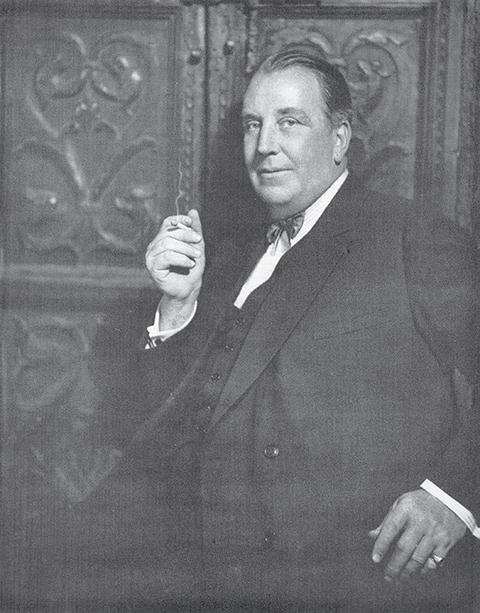


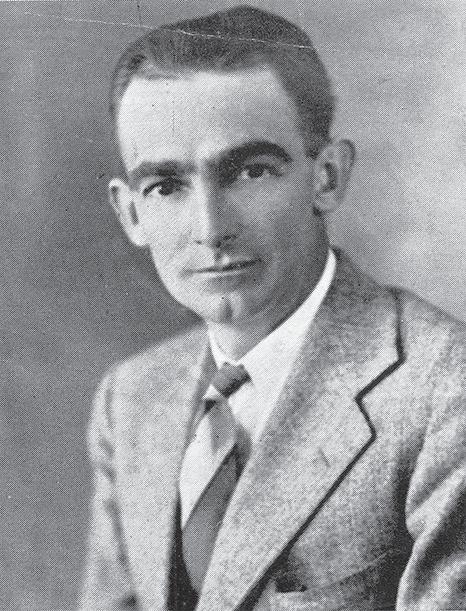


(1) Addison Mizner, a 1920s South Florida architect, city planner and real estate developer had a vision of what could be. Mizner purchased the property and, working with his assistants in a small bungalow (2) in the middle of a mud flat laid out the first plans for a town that became named Boca Ratone. Promoting his dream town to prospective home buyers in ads (3) as “the most beautiful place in the world,” he set in motion a Centennial success story. Boca Raton was officially incorporated as a city on May 25th 1925, with Mayor John Brown (4) elected as its first mayor, serving from 1925-1929. The city’s population by 1929 was about 5,000…up from about 200 in 1920. Today, (5) the City of Boca Raton has a population of about 100,000 residents with about 14,000 registered businesses. 1,300,000 people visit Boca each year from outside Palm Beach County and 670,000 additional visit from within the County. The City of Boca Raton’s present annual operating General Fund budget is $247,425,400 managed by Mayor Scott Singer (6) and the City Council. Mayor Singer is the city’s 35 th Mayor. He was first elected Mayor in 2018, re-elected in 2020 with 89% of the vote—receiving the two highest vote totals in the city’s history—and re-elected without opposition in 2023.
As the City of Boca Raton launches a year-round schedule of activities and events to celebrate its 100th year—all of which we look forward to covering for our readers in the pages of Boca Club News —the Boca Raton Historical Society is presenting a fascinating and highly recommended multi-media exhibition that showcases our city’s past century of development.
It all began when Addison Mizner’s skill and vision as an architect, city planner and industrialist produced the innovative and enduring designs that created Boca Raton, one of the world’s ultimate resort destinations and residential communities.
“Contemplating the previous decades of progress gives us the foundation, perspective and inspiration to make the
The happy faces in this photo are some of the Broken Sound tennis team members celebrating their nine matches to five victory over St. Andrews in the longrunning consistently hardfought but friendly rivalry between the two clubs. This year’s competition, held at St. Andrews’ courts December 8th for the first time in four years, consisted of 14 matches: 4 men’s doubles, 7 ladies’ doubles and 3 mixed doubles. By the tournament’s tradition, the official trophy will once again—as it was all last year—be on display in Broken Sound Club’s Tennis Pro Shop with its newly engraved, updated results.



next century even greater than Addison Mizner could have ever imagined,” notes Mary Csar, Executive Director of the Boca Raton Historical Society.
Mizner’s Old World architectural style and manufacturing concerns transformed South Florida’s
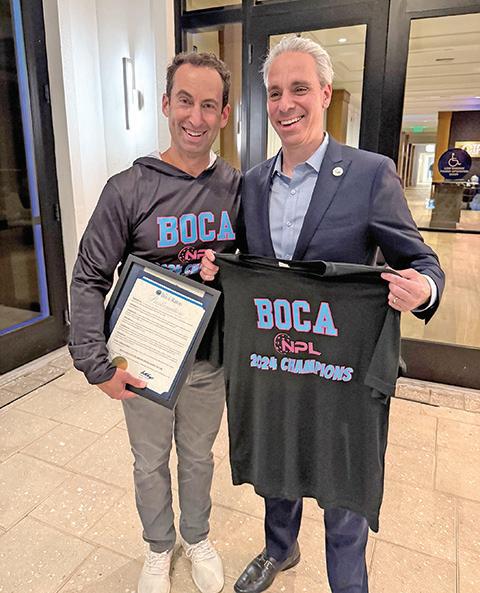
Time! Boca Raton Mayor
right, with Picklers’ team member Brian
presented the Boca Raton Picklers Pickleball Team with a Key to the City and Proclamation during a watch party of the 2024 NPL National Championship victory. The event was held at Broken Sound. The Picklers presented Mayor Singer with a team jersey. The team also showcased their championship win by participating in the Boca Raton Holiday Parade.






















The City of Boca Raton will kick off its milestone Centennial year with Boca Street Fest, a new signature annual downtown festival set for Saturday, January 25th from 12 p.m. to 4 p.m. at the Mizner Park Amphitheater, and throughout Mizner Park along Plaza Real. Admission is free.
Boca Street Fest will feature a dynamic lineup of live entertainment including local bands Spred the Dub, Leave it to Us and Wolfhawk; a bustling community marketplace with a curated selection of local vendors; a lively beer garden, and plenty of surprises in the heart of Boca Raton.
“Boca Street Fest is all about bringing our community
together to celebrate the vibrant spirit of our city,” said Mayor Scott Singer. “From live music and local flavors to unique vendors, this festival showcases what makes Boca Raton such an exciting place to live, work and play. We’re kicking off a year of Centennial celebrations with something for everyone, and we can’t wait to see you there!”
The City of Boca Raton will commemorate and honor the life and legacy of Martin Luther King, Jr. with a day of free community events and celebrations on Monday, January 20th.
Activities throughout the day will include:
8 a.m. to 10 a.m. Free Community Breakfast, themed “Don’t Give Up On the Dream,” courtesy of Developing Interracial Social Change (DISC) at Ebenezer Baptist Church Hall, 200 Ruby Street.
10 a.m. March along Federal Highway from the MLK Jr. Memorial, 200 Ruby Street, to the Mizner Park Amphitheater, featuring Boca Raton Community High School Band & Color Guard. Trolley service is available for those requiring assistance.
10:30 a.m. to 11:20 a.m. Join community leaders and local organizations for a ceremony to honor the life and legacy of Martin Luther King, Jr. at the Mizner Park Amphitheater. Features include keynote speaker Dr. Alisha Winn, a Mayoral proclamation, speeches from
The holiday season officially kicked off with CP Group’s 9th Annual Tree Lighting on November 21st at Boca Raton Innovation Campus (BRiC). Emceed by WPTV’s First Alert Chief Meteorologist Steve Weagle, the event drew over 2,500 attendees from the Boca Raton and neighboring communities. Residents gathered to enjoy the festive atmosphere and a night of holiday cheer with the traditional lighting of a 40-foot tree, a meet-and-greet with Santa, live reindeer, interactive experiences and local entertainment.

The event kept with the nine-year-tradition of supporting two local causes, the Spirit of Giving and the Junior League of Boca Raton. Access to the event was free for those who brought a new, unwrapped toy to Spirit of Giving. CP Group collected over 2,000 toys, which will support the nonprofit’s Annual Holiday Gift Drive, spreading joy to thousands of 9th Annual Tree Lighting on page 4


Dr. Rosenbusch has been practicing dentistry for 34 years and has extensive experience in many aspects of dentistry. His main focus is on Cosmetic Dentistry, Laser Dentistry and Implant Prosthetics
community leaders, poetry, music and a Humanitarian Award presentation.
11:30 a.m. to 3 p.m. Celebrate a unified community with a variety of live performances, amusement rides, games, community partner booths, a photo booth, stage performances, food and beverages available for purchase, a service project and more, at the Mizner Park Amphitheater.
For more information, call (561) 367-7073, visit www. myboca.us/communityevents and follow Boca Raton Recreation Services on Facebook.
Boca Raton Celebrates 2025 Centennial Year! from page 1
landscape and building industry and fostered today’s outdoor lifestyles. In nearly every Boca Raton neighborhood, houses and apartment buildings feature patios, terraces, loggias and courtyards detailed with Mizner’s wide-ranging artistry borrowed from Spanish medieval towns, Italian Renaissance villas and Venetian Gothic palaces.
The current exhibition’s centerpiece spotlights the Mizner-designed Cloister Inn’s evolution into a 300-room private sporting club that, after World War II as part of the Schine hotel chain, opened its doors to the community. Today, Mizner’s dream has become The Boca Raton, a 1,000-room, multifaceted resort secluded on hundreds of acres.
The exhibition’s extensive artifacts and furnishings offer museumgoers a multi-dimensional experience, documenting the city’s past 100 years of development with photographs, drawings, maps and videos conveying historical narratives that resonate the past. Additionally, the Frederick Herpel Collection provides a spectrum of historical materials produced and imported by Mizner Industries. Among them, floor and roof tiles, sculptural cast stone, fireplace mantles, Corinthian column capitals, pottery and furnishings afford valuable insight into Mizner’s creative process. Other lenders to the exhibit include the Mizner Library Foundation, Inc., the Historical Society of Palm Beach County and the Bonnet House Museum & Gardens.
Admission to the entire museum, including this exhibition, is $12 for adults, $8 for students and free for ages under 6 and museum members.
Augustus Mayhew is the guest curator for this exhibition. Mr. Mayhew is a cultural columnist, architectural historian and photographer. He served as editor and principal writer for the recent publication of “Addison Mizner: A Palm Beach Memoir,” has functioned as curator for several other Addison Mizner museum exhibitions and is the recipient of the prestigious 2023 Judge James R. Knott Award for his contributions to the preservation, promotion and enrichment of Palm Beach County’s history.
The Schmidt Boca Raton History Museum is the home of the Boca Raton Historical Society, whose mission is to collect, preserve and present information and artifacts relevant to the past and evolving history of Boca Raton and to maintain a visible role in the education and the advocacy of historic preservation in the community. It is open to the public Wednesday through Saturday, 10 a.m. to 4 p.m. The museum is in historic Town Hall at 71 N. Federal Highway (33432). For more information call (561) 395-6766 or visit www.BocaHistory.org
bocadentist12@gmail.com













I have cash buyers that are currently looking for the following. Call me now if you are thinking of selling in the near future.
Buyer 1. Courtyard style home up to 3.6 million depending on condition
Buyer 2. Single family home up to 2 million. They will renovate if needed.
Buyer 3. Home with 2 bedroom plus a den. 800k-1.5 million. They will renovate.
Buyer 4. Home in Whisper Trace, Laurel Point or Timber Mill with primary suite on the ground floor

KCOM-PR’s
President and Chief
Strategist Bonnie Kaye has been tapped to serve on the Dean’s Advisory Board for the Dorothy F. Schmidt College of Arts and Letters to advise the Dean and to assist him in strategic planning, the development and implementation of shortand long-term goals, community outreach and

the garnering of financial support for education, research and public programs.
While serving, Bonnie will focus on supporting the annual CAST Party, the College’s major “fan and scholarship fund” raising event for student scholarships and the Dean’s Jewish Leadership Advisory Board to increase awareness and community engagement for the future Kurt and Marilyn Wallach Holocaust and Jewish Studies building on FAU’s Boca Raton campus.
The Wallach building will become the epicenter for intercultural dialogue and education in the greater South Florida region, empowering the next generation of changemakers. It will memorialize those who perished in the Holocaust, honor its survivors and bring together educational
programs that champion social justice, compassion and understanding through enhanced collaborations that strengthen the prominence of these programs.
The College of Arts and Letters houses 21 academic programs including the School of the Arts, along with humanities degrees, social science degrees and the areas of communications and architecture. It also houses the college’s Center for Peace, Justice and Human Rights; Center for the Future Mind; Women, Gender & Sexuality Studies; Global Studies; Jewish Studies, among others that bring together multidisciplinary education focusing on human rights’ education, conflict de-escalation, ethics and diplomacy, leadership training and peacemaking.
The City of Boca Raton, in partnership with the Greater Boca Raton Beach and Park District, celebrated the installation of Boca Raton Mosaic Composition 1, a new public art piece which adorns the Family Pavilion wall at Sugar Sand Park.

The new art installation is a vibrant mosaic mural, 31 feet wide x 11 feet tall, created by renowned naturalist artist James Prosek and produced by award-winning tile company Artaic. The mosaic mural commemorates the Beach and Park District’s 50th anniversary and showcases the rich flora and fauna of South Florida’s natural environment.

Editor Nils A. Shapiro

Tom
Made of glass tiles, Boca Raton Mosaic Composition 1 features hand painted and silhouetted species including sabal palms, mangroves, loggerhead turtles, morning glory, ibis, zebra longwing butterflies, osprey and more.
Unveiled on December 6th, the project is the first permanent art installation of the Public Art Boca program, part of the city’s Recreation Services Department, whose mission is to enhance public spaces with captivating and engaging artwork.


Now permanently on view at Sugar Sand Park, 300 S. Military Trail, the Mosaic wall is available for viewing Mondays through Saturdays from 8 a.m. to 11 p.m., Sundays from 8 a.m. to 8 p.m.











New Beginnings: The new year is an opportune time to buy real estate. These two turnkey townhomes for sale in Broken Sound Club are nothing short of spectacular!

2530 NW 52nd St., Boca Raton, FL 33496
4 Bed/3 Bath/2,200 SF Interior
Two-story townhome, gorgeously renovated!
Offered at $759,500

2273 NW 53rd St., Boca Raton, FL 33496
3 Bed/2 Bath/1,650 SF Interior



The De Marzo Luxury Group are the ultimate dealmakers! In 2024, DLG closed 32 deals resulting in $27.4 million in sales (YTD). We were named top small team in Boca Raton and The Palm Beaches by Coldwell Banker. Let us assist you with all your luxury real estate needs in 2025. May you have a happy, healthy and sparkling New Year!


Single-story townhome, sweeping golf course views! Offered at $698,000





A comedic romp adapted from the Garson Kanin play “Peccadillo” by awardwinning playwright Joe DiPietro will run from January 17th through January 26th at the Delray Beach Playhouse. It is a Boca Stage Production.
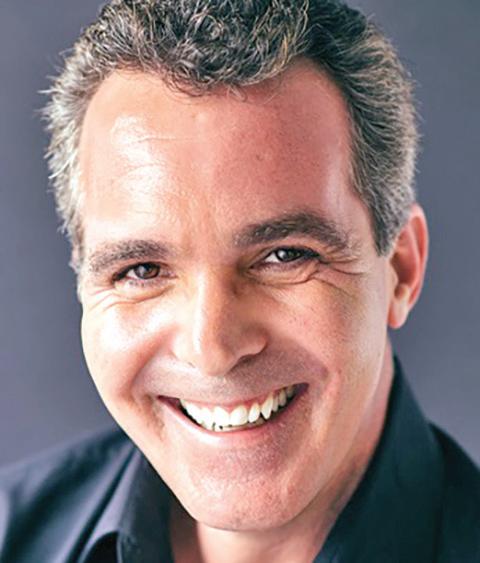
In a story set in New York City in 1957, the entertainment business is skewered and satirized with two characters: Raquel, the leading opera diva of the day and Vito, her husband, an equally short-tempered, egomaniacal Italian maestro. These two, through their petty jealousies, comically manipulate each other’s feelings as they square off to write their individual memoirs with the help of some befuddled ghostwriters, all the while exhausting their household staff.
“We picked this play to keep the season diverse with an allout comedy,” says the play’s director, Keith Garsson. “We have a terrific cast, well suited to their roles: Mallory Newbrough— well known for her dynamic musical performances—will make her Boca Stage debut as the Diva. She is equally matched by Boca Stage regular Wayne LeGette as her shortfused Maestro husband.
Delray Beach Playhouse regular Jim Tyminski and Boca Stage regular Amber Lynn Benson play the put-upon ghostwriters continually exhausted by the bickering couple’s endless shenanigans. And we welcome Jack Stein and Matt Schenck as the loyal







yet continually put-upon house staff, always one step ahead of their employers.
“You never know what’s going to come out of this crazy couple’s mouths,” Garsson continues. “Upon first reading I could not believe the sheer savage glee this couple took in teasing and taunting each other. The play is a complete takedown of New York’s privileged class.”
Tickets for “Living on Love” range in price from $59 to $69 and are available online at delraybeachplayhouse.com or by calling (561) 272-1281. Performances are on Thursday, Friday and Saturday at 7 p.m. and on Saturday and Sunday at 1 p.m. There will be a matinee performance on Wednesday, January 22nd at 12 p.m. All performances will take place at the Delray Beach Playhouse, 950 NW 9th Street in Delray Beach.
Scott Singer is the 35th Mayor of Boca Raton and was re-elected in 2023. A South Florida native, attorney and small business owner, Scott and his wife Bella live in Broken Sound with their two children.
Boca Raton’s centennial is officially underway and we are excited to celebrate 100 years of growth, innovation and community.

Over the past 100 years our city has transformed into a dynamic place that is thriving with culture, business and natural beauty. We look forward to honoring our past and looking forward to the next century with many community events and symbols that pay homage to our rich history.
If you visit Sanborn Square in the beginning of the year you
will notice a new public art sculpture, “Reflections of Time.” If you have called Boca Raton home for decades the piece may look familiar. It replicates the major mid-century Boca Raton landmark in the 1960s that welcomed residents and visitors to our city.
The first official centennial event, Boca Street Fest, will take place from noon to 4 p.m. on January 25th at Mizner Park Amphitheater. This new downtown event will feature live performances, a beer garden and marketplace of local vendors.
While 2025 will feature a number of events, including a concert and drone show on Memorial Day weekend, marking our centennial is also about shaping our future.
This centennial milestone provides an opportunity to reflect on the achievements of the past and think about the type of
Mayor’s Update on page 10

By Dale Brown, B.S., M.A., C.E.C.

Dale is a motivational speaker who has spent many years as a Certified Life Coach and has written numerous articles and e-books relating to selfimprovement and ways to build a high-performance team. She is the author of the book, “Small Steps...Big Changes: The Personal Stories of a Life Coach.” Her education and years of experience in physical fitness and training of elite athletes has enabled her to sharpen her knowledge in many health-related areas. The following introduces a new approach to Ms. Brown’s series of columns devoted to many topics that deal with the mind/body connection and the importance of living a healthy lifestyle. Dale, a Bocaire resident, can be reached at dalebrown@lovingmondays.com.
It’s that time of year when millions of Americans resolve to make lifestyle changes. Whether it’s to lose weight, exercise more or eat healthier, the start of a new year sparks enthusiasm and motivates people to get going. You’ll likely hear familiar phrases such as, “I’m cutting back,” “No more carbs,” “I’m on a new diet.”
Throughout my life I’ve seen diets come and go, each claiming to be the perfect solution to quickly shed unwanted pounds. Who would have thought that there would one day be an injectable drug, such as Wagovy or Ozempic, that could help control diabetes as well as obesity? For some these medical miracles are heaven sent. But for others they can be overkill. Outside of side effects from the drugs, they aren’t prescribed for a lifetime. There are endless stories of how individuals stopped their medication only to see the pounds come pouring back on.
Many people aren’t usually looking to shed 50 lbs. or more; they might simply want to look and feel better in their clothes. Holiday eating and drinking has taken its toll and the time of reckoning is here. So, what’s the best recommendation for
shedding unwanted weight? It might be “a long winding road,” but try to find an eating style that works for the long run!
One of the most popular methods is the concept of intermittent fasting. Other diets outline what foods to eat, but in this case the word is when. Fasting has been found to be effective for losing weight while protecting against muscle loss. There are several different ways fasting might be beneficial. Here are two of the most common.
The first is the 16/8 method, which suggests you restrict eating to an 8-hour window. This can easily be done by not eating anything after dinner and eating a late breakfast. This is not for everyone, but I for one find it easy to do because I’m not a morning person. If I finish dinner by 8 p.m. and eat by 11:00 a.m. the next day I’ve easily met the requirement.
The second concept is the 5/2 diet, which involves breaking up the week between eating normally and eating fewer calories two days a week. For example, you may choose to eat small meals on Mondays and Thursdays (250 calories for women and 600 for men) and eat as usual the rest of the time. This type of fasting seems to work better for those whose main meal of the day is a hearty breakfast.
When coaching athletes and counseling them on proper nutrition, my mantra was always and still is. “Calories in, calories out!” It’s as simple as that. If you eat more than your body burns it ends up as fat somewhere on your body. I hear people say, “Oh, I tried that diet but it didn’t work for me”. Some folks seem to always be on a diet, yet for some reason they end up right back where they started. Why?
The answer is simple. Most diets do work if you make the commitment to practice the designated regimen. Diets don’t work when you sabotage your own efforts to succeed and blame it on the diet. In my coaching practice I have identified types of behavior that are responsible for failing to reach a desired weight loss goal.
The procrastinator – This person is good at telling you what they’re going to do: load the Weight Watchers app to
keep track of calories, join a fitness class, walk 10,000 steps every day. Sounds like a plan, but six months later you find them still sitting on the couch, explaining that their busy schedule got in the way.
The Overachiever – These folks set goals way beyond what’s realistic. Have a class reunion coming up, a child’s wedding, or some other big occasion? Okay, you want to lose 50 lbs. by whatever the date may be. A healthy weight loss is one to two lbs. per week, so if you have two months before the big day, the goal may be impossible to reach.
The Meal Skipper - “I haven’t eaten a thing all day so I can afford to chow down on chicken nachos and a couple beers. It all evens out at the end of the day!” WRONG. Don’t skip meals unless you’re following a specific fasting program. Your body stores fat and holds out for the next meal, which is counterproductive to losing weight.
The Snacker – Snacking isn’t always a bad thing to do, but it has to be nutritious. Eating several small meals a day is more likely to control hunger and keep your metabolism in high gear. Nuts are a good choice but consider apples, trail mixes, carrots and celery, need I say more?
The Low-Fat Expert – “I only buy low-fat items, which helps keep my fat content down.” Whoops! Low-fat does not translate to low-calorie. Check your carbs, fat, sugar and calories on the nutrition label for a real eye opener.
The Drinker – Did you know that some shakes, coffee drinks and alcoholic beverages contain more than 500 calories? Watch out because you’ll still eat the same amount, but tack on those extra calories for the drink!
Dieting is hard; eating and drinking is easy. Don’t blame the diet on your inability to lose weight. For best results find a healthy way of eating that you enjoy and can follow for life. Moderation and portion control are key along with daily exercise. Once you find a diet that works best for you stick with it. And remember to always check in with your health professional before starting any diet.
By Richard Nagler, M.D.,
a member of Broken Sound Club and retired physician. After graduating from the University of Pennsylvania and New York University’s School of Medicine, Dr. Nagler served his internship and residency at Baltimore City Hospital and Johns Hopkins. He followed that with a Fellowship in Gastroenterology at Yale University School of Medicine, and was then Chief of Gastroenterology at Fitzsimons General Army Hospital in Denver. He returned to the Yale Medical School for one year as an Assistant Professor of Medicine before opening his own successful private practice in Internal Medicine and Gastroenterology. During that time, he also served for ten years as Chief of Medicine at Huntington Hospital in Huntington, N.Y. There are approximately 64 million seniors enrolled in Medicare. Over the years more than half of them have opted to transition to a Medicare Advantage plan.

Traditional Medicare is operated by the federal government while Medicare Advantage plans are run by private institutions. Traditional Medicare consists of “A” for hospitalization and “B” for doctors and other services. There is no premium for “A” but premiums are charged for “B” and are usually automatically deducted monthly from Social Security.
Because Medicare does not pay 20% of costs most people opt for a supplemental Medigap policy which they pay privately for coverage. In addition, there is available plan “D” for prescription drug coverage at additional cost, which most people arrange with a private insurance company.
With traditional Medicare denials are very rare. Deductibles and copays are usually covered with supplemental insurance. With a Medicare Advantage plan there is no need for supplemental or medigap insurance nor for a plan “D” as they are included along with both “A” and “B” coverage. In addition, these plans often include limited dental care, hearing tests and certain hearing aids, as well as prescription eyeglasses.
However, there is a deductible that must be reached after which all costs are covered 100%. Combining all these features can result in cost savings for subscribers. Importantly, though, all seniors are eligible for Medicare with no restrictions for preexisting conditions. All participating hospitals and doctors must accept Medicare fee schedules. Patients can see any doctor of their choice, and do not require referrals to see
a specialist. They are covered when travelling. Preventive medical care is included.
During the yearly enrollment periods we are all deluged by TV and other media advertisements advising us to switch from traditional Medicare to a bewildering array of Medicare Advantage plans. There is considerable confusion when considering these plans. They are privately administered and are designed to make a profit for the insurers.
There are three major downsides to these plans. First is denial of claims. While traditional Medicare rarely if ever denies claims, Medical Advantage plans have a 7.5 % denial rate. They challenge the patient and the doctors as to whether the treatment or procedures are necessary.
Approximately 10% are appealed, mostly successfully, but the patient must go through a long-drawn-out frustrating process which can be maddening. The second negative is the requirement of prior authorization for almost all medical costs except for an emergency. This results in high rates of denial and delays in both care and reimbursements to the doctors and hospitals.
The third problem is that subscribers do not have a free choice of a doctor. They must use a doctor on a list provided by the insurance company and require a referral to a specialist on a similar list. Especially in rural areas, the list may be very small where there is already a significant shortage of primary
care doctors which presents a very difficult situation in having any doctor available at all for these subscribers.
Many doctors and hospitals have opted out of Medicare Advantage plans because of the need for prior authorization and denials resulting in time-consuming hassles with the insurance company and long delays in reimbursement. It is estimated that 50% of subscribers switched out of Medicare Advantage plans over a five-year period, usually to another plan with only a few back to traditional Medicare.
While 46% of doctors accept Medicare Advantage plans it is now estimated that 20% of doctors and hospitals have stopped accepting Medicare Advantage plans leaving millions of patients in jeopardy. The reasons given are delayed reimbursements, cumbersome prior authorization requirements and high rates of denials. It has become a game of delay, delay and do not pay. People who wish to switch back to Traditional Medicare must wait to do so during the annual three-month enrollment period.
In this column I have focused on the essential factors that people should consider when, and if, choosing to switch from traditional Medicare to a Medicare Advantage plan. There are many less important considerations that would only serve to add confusion in making such an important decision.
One thing we must not forget is that you don’t get something for nothing.
By
Michael J Posner, Esq., a partner in Lippes Mathias LLP, a national real estate and businessoriented law firm with sixteen locations nation-wide. Michael specializes in real estate and association law. He can be reached at 561.594.1452 or at mjposner@ lippes.com

As the former owner of a brick house built in 1937 I was quite aware of some settlement cracks in the exterior. However, when I tried to sell the house, the buyer’s inspection report stated, “STRUCTURAL CRACKING: Cracking that appears to be of a structural nature is present. Suggest further evaluation by a structural engineer.” This was enough to cause the buyer to walk from the purchase
despite my verifying with a structural engineer that these were ordinary settlement cracks and not a sign of structural problems in the foundation.
A buyer of a 1946 house contacted me after their inspection revealed settlement cracks. They had a foundation repair contractor inspect who gave them an $8,100 estimate. After another structural engineer inspected the property it was determined that the cracks were only due to minor settlement and not a significant structural problem.
In the news recently was fears of excessive sinking of a large condominium in Miami. The headline screamed, “The Porsche Design Luxury Skyscraper in Miami Is Sinking Much Faster Than Expected. A twelve-story residential building nearby collapsed in 2021.” The article then detailed Legal on page 13
how a University of Miami study of 35 coastal buildings along Miami’s shore reported they have sunk between 0.8 and 3 inches.
Given the collapse of the Champlain Towers building in 2021 there has been a renewed concern regarding the status of the luxury waterfront condominiums and their long-term viability. While the Champlain building collapse was due to neglected maintenance, poor construction and water intrusion, excessive settlement can cause major problems to a building’s long-term health.
Settlement issues are common in all properties. The weight of a building, the pull of gravity and the shifting of the underlying soil will all cause a building to settle. The ground on which a building is built will also affect the amount of settlement. For example, The Tower of Pisa leans because it was built on soft, unstable ground, primarily composed of clay and sand, which caused the foundation to sink unevenly during construction. Much of South Florida is built upon limestone which is naturally softer and more porous than the granite underlayment. This softness can contribute to increased settlement (as an aside, it is also why the water is so hard in South Florida and the pizza and bagels do not taste as good as up North).
Besides the type of soil beneath a building, settlement occurs due to a variety of factors. Proper demucking and/ or compacting a vacant lot prior to construction can reduce settlement. If the soil is too loose or sandy it will not be able to withstand the weight of the building, leading to faster
or more pronounced settling. Proper choice of building materials and density calculations become a major issue for large buildings. The type of foundation can affect the rate of settlement with concrete being generally more resistant to settling than other materials, such as wood or steel beams (as is found in older homes).
Climate change can also affect settlement. Constant water pooling around a building’s foundation can lead to increased uneven erosion that accelerates settlement. It is also common for new homes to have settled in the first year that leads to creaking and groaning sounds as if the building is haunted; in most cases this is normal.
The amount of settlement and the unevenness is what causes issues in a building’s foundation. If the settlement is uneven the building will have settlement cracks in the exterior wall. The flooring in the interior may crack, and the flooring may become uneven. A simple rolling pen or small ball when placed on a floor can be evidence of uneven settlement.
When purchasing a home, especially an older home, a thorough inspection of the foundation must be made to determine if the visible signs of settlement actually mean a significant structural issue. Small settlement cracks generally do not indicate a problem, but these cracks should be properly sealed/caulked to prevent water intrusion. Larger signs like cracked dry walls, misaligned windows, large cracks in the flooring, uneven or sloped floorboards and gaps between the ceiling and walls are all indications of a settlement issue and should be noted by your building inspector.
If an inspection reveals substantial settlement issues, it will be necessary to effectuate repairs to the foundation. Depending on how the building is constructed will affect the method used to make repairs as well as the severity of the settling. Minor settlement can be addressed with slabjacking/mudjacking. After determining the best location to lift the slab the contractor will inject a grout mixture under the concrete slab to raise it back to a proper level. If the settlement is substantial it may be necessary to install support piers like helical piers or push piers, which are driven deep into the ground to stabilize the foundation.
















By Alan Serinsky
of
Bocaire
Country Club. Hungry Al’s love for food started very young. Never satisfied with his Mom’s dishes, he started to cook his way through her “Betty Crocker Cookbook.”

During the years to follow he spend many hours working in restaurants, both as server and cook, attending cooking classes and traveling the world in an effort to expand his palette. As a professional writer, Hungry Al offers his perspective on current food trends and guides you through your local restaurant options.
Deluca’s Chophouse
499 S. Federal Hwy., Boca Raton, FL 33432
561-677-8863
delucaschophouse.com
Food for Thought: Have you ever been to a place that instantly sparks childhood memories? Well, my recent visit to Deluca’s Chophouse was certainly one of those places. It brought back the same feeling I had when my Dad took the family to Little Italy in NYC. I reminisced walking down a few steps into a basement restaurant that had that Godfather feeling. What also resonated was the ever-familiar greeting my Dad got when he approached the tuxedo-dressed Maître D’. Obviously, there was a personal connection, one that I hesitated to ask about.
As a kid these types of theme restaurants were fun and interesting. But as I’ve gotten older they seem less impressive and more Disney-like. This type of décor initiative seems to play to our senses, not our stomachs. I personally find them to be more of a distraction than an enhancement to how I envision my evening will unfold. All Hungry Al asks for is an evening of togetherness with friends or family, great conversations, a sip of good wine, well prepared quality food and a kiss from my bride! Deluca’s thankfully delivered on most of these requests. First Impressions: This location has been through the revolving restaurant doors of Boca for some time. It would take two hands to count the establishments that have come and
gone on this corner of Federal Hwy. The last three were The Ovenella, The Little Chalet and Locale. Now we have Deluca’s Chophouse that is rolling the dice on having a Godfather theme to draw all those New Yorkers back to their Italian roots. But herein lies my rub.
The dining room is like something out of an Italian wedding. Gold lacquered banquet chairs (very uncomfortable), a hanging John Travolta spinning-lit disco ball, television screens looping Godfather movies, a female wedding singer skating around way too loud at times, and a different waiter at every turn. I might consider a Happy Hour at the nice extended bar on my return.
Prime Your Taste Buds: First to note...the bread basket was average and the tinfoil butter pats need to stay at the local Denny’s. As for your wine-by-the-glass, you can expect a carafe pour of 5-6 ozs. for about $14. So don’t complain to the “boss”; just order a bottle.
To start off we all decided to share a few of Deluca’s appetizers. First up was the traditional meatball evaluation. This is a priority item off the menu that I find hard to resist. Thankfully, Deluca’s Homemade Meatball ($14) wasn’t on our “hit list.” This bocce ball size combination of veal, beef and pork was delicious and every fork got a piece of the action. We then scooped up every Clams Casino ($19) like they were candy out of a bowl. The clams were tender and not overly stuffed, allowing for the clam to take center stage. The Caesar Salad ($18) was a Caesar Salad! I’m still scratching my head how the price of some chopped romaine lettuce and a few croutons got to be so expensive.
Straight From the Kitchen: Hungry H was flapping his fins for Butterfly Branzino ($48) that was pan seared with a white wine lemon sauce. The chef masterfully treated the sauce with lemon to enhance but not overpower the delicacy of this fish. It was joined by a few Jumbo Asparagus and Sautéed Spinach that were both seasoned and cooked properly. I think you could net this fish for two.
Hungry D went for a true taste of Italian cuisine, the homemade Bucatini pasta ($22). This was not found on the menu but chef nicely accommodated her request. The pasta was spectacular and, thankfully, not over- nor under-cooked.





The easy hand on the marinara sauce was exactly the way you would get it delivered from any kitchen in Italy.
Hungry S came with a hungry appetite this evening and decided to challenge herself by ordering the Hulk-sized Veal Chop Parmigiana ($58). This huge pounded (probably with a sledgehammer) breaded and pan sautéed chop was plenty to conquer her hunger pains and enough left over for me to polish off.
As for Hungry Al, my selection was the Veal Marsala ($34). If you like this dish you won’t be disappointed. The chef utilized the Marsala wine perfectly to give it that subtle sweet flavor and added enough veal stock to deliver a silky-smooth sauce, all enhancing the tender veal and sautéed mushrooms.
Note: The Chophouse label added to this restaurant’s name is there for a reason. You have an array of USDA Prime cut meats from a Tomahawk for Two 40 oz. ($149) for those with a big appetite to a Bone-in Ribeye 22 oz. ($78).
From the Dessert Tray: Yes...here at Deluca’s “you can leave the gun and take the Cannoli” ($13). This crisp pastry was filled with rich sweetened ricotta cheese and will have you wanting a double order. Or, you can have the traditional Tiramisu ($13) or New York Cheesecake. But our waiter highly recommended Arianna’s Butter Cake ($15). This gooey buttery crumb cake was advertised to melt in your mouth (overstated) with vanilla ice cream and fresh berries. It was a great suggestion and the table left the plate clean.
Check Please: Even though I felt like I was reliving Saturday Night Fever without my long-lost peach leisure suit (yes...I owned one), Deluca’s Chophouse shot straight hitting all the targets on good food and service. As all good mobsters know...always keep an eye on the door. And from where I was sitting it seems that Deluca’s is drawing a crowd even on a non-weekend night.
As for the Hungry Squad, we neither danced a disco nor sang a duet with the entertainer, but we did leave with the satisfaction of a great meal. If you’re looking for a piece of Vegas nostalgia or a theatre-like Al Capone atmosphere, why not give it a try? So as not to “dis” the family we decided to give Deluca’s three and a half Golden Disco Balls.




By
Nils A. Shapiro. Nils began his career as Marketing Director for a major book publisher. He has since edited the authors’ manuscripts’ for more than 20 published books, written more than 200 book reviews, served as Publisher of several million-plus circulation national magazines, created the official Yearbooks for teams in Major League Baseball, the National Football League, National Basketball Association and National Hockey League, and “retired” as President of a successful telecommunications company before being appointed Editor of Boca Club News when the newspaper was launched in January 2007.

As miraculous as is the now common practice of being guided by an invisible voice as you drive miles through streets and down highways, making left and right turns on command until you arrive at your pre-determined destination, the true background story of how this technology—the Global Positioning System (GPS)— was created and developed is equally extraordinary, and it is told here in impressive detail thanks to the clearly exhaustive depth of research by author Greg Milner. After 266 pages of text there are an additional 50 reference pages.
I must state at the outset that I am fascinated by the way that the GPS technology is able to provide its driving directions to the general public. I was sufficiently intrigued to keep turning the pages to the very last one even though, because of other important events in GPS’s history and other ways in which it is used, the author took so many narrative detours that (ironically, considering this book’s subject matter) it frequently left a “non-techie” like me lost for a while.
But it has been well worth the trip. And here are just a few of the hundreds of things you will learn here to underscore my recommendation that you dip into “PINPOINT”…especially if your technology I.Q. exceeds mine.
- There is a constellation of 31 GPS satellites orbiting more than 20,000 kilometers above planet Earth. Every few minutes 16 U.S. Air Force monitoring stations around the world, from Kwajalein Atoll in the Pacific to the South of England, collect data from satellites coming over the horizon, noting speed and trajectory based on 1,200 different protocols that tell how the satellite is performing. There is no room for error. Among other uses, all the world’s atomic clocks base their timing on these satellites. And for drivers, if a satellite’s timing is off by one millionth of a second the directions can send a driver as far as 200 miles from the desired destination!
- America’s first interest in developing a technology that would later become GPS began in earnest during World War Two. Its purpose: to kill people more efficiently by making our airplanes’ bombing raids over Germany and Japan more accurate. Although the facts were kept from civilians at home, the truth was that the Army Air Corps’ doctrine of high-altitude bombing to avoid hazardous daytime raids resulted in targets often being missed by more than a mile.
And then, for decades, our military sabotaged at every opportunity the use of GPS for civilian purposes! This is one of the most frustrating themes that runs through much of the book, a constant example of the shortsightedness of the American military in its obsessive concern about technology getting into the hands of an enemy. It was left to private industry to do the job.




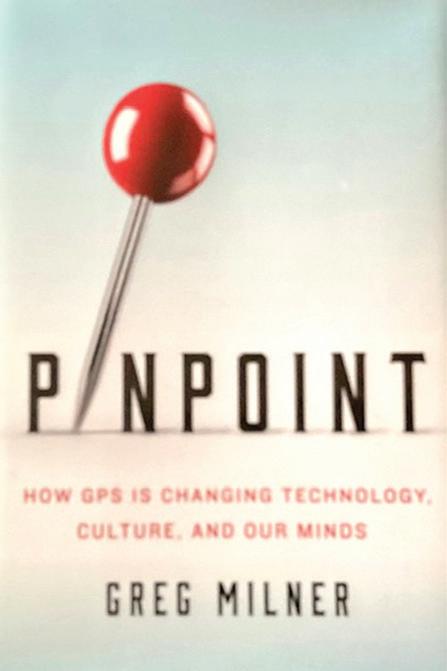
Interestingly, one of the individuals who played a role in its development was an immigrant who, hating and fearing Ayatollah Khomeini, fled from Iran hoping to work hard and bring his wife and children to the U.S. He was hired in 1981 by a tech firm, Trimble Navigation, was fascinated by the concept of GPS and was instrumental in the introduction three years later of their first GPS receiver.
- The book’s first two chapters are fascinating in describing centuries of mankind’s search for an answer to the question, “Where am I?” On a planet that consists more of water than land, with no identifiable markings and a flat surrounding horizon, travelers on the open ocean were forced to reckon by the sun, moon and stars.
As the author notes, “In seafaring and navigational terms, while the Europeans were discovering fire, the Polynesians had already split the atom. They crossed the ocean in canoes roughly 60 feet long, built from hollowed-out trees, with sails made from woven leaves… And yet, with no compass, sextant, or any other modern navigational aid, explorers in canoes found tiny oases scattered across one-third of the planet, an expanse nearly as vast as Europe and Asia combined.”
- As part of its ongoing attempts to prevent civilians from deriving the full benefits of GPS technology the Pentagon in April 1990 established a two-tier coding to enable the satellite service. The restricted one was labeled
SA, which stood for Select Availability and was reserved for the military. Four months later Iraq invaded Kuwait in Desert Storm and a private American company, which had developed a highly efficient small receiver called the Trimpack—filled a Pentagon order for 1,000 units that enabled U.S. forces to know where they were in the open spaces of the desert, providing one’s latitude and longitude, directions to another location and even store the GPS coordinates of special battle maneuvers. In order to do so it needed to have Pentagon clearance for SA access. But when that company ran out of their Trimpacks another firm, Magellan, offered a substitute of their own that could provide most of the same benefits. “Despite a price tag of $1,000 soldiers wanted these Magellans—even if they had to pay for them out of their own pockets. Their families called the company, which directed them to marine retail outfits. The most enterprising soldiers would manage to call Magellan directly from the Gulf and arrange for the company to ship the receivers directly to them.” - When the private companies began to develop GPS technology their focus was on the mariner (boaters’) market, not automobile drivers. In 1989, Gary Burrell and Min Kao started their Garmin Company (named from the first parts of both their names) and soon proved them wrong: “By 2006, Garmin controlled 60 percent of the U.S. for navigation equipment. Americans bought five million Garmin GPS receivers that year, as the company posted $1.68 billion in sales, a 64 percent increase from 2005. Fully half of the company’s revenue came from GPS units, with sales in that segment growing at an astounding 140 percent annually.” U.S. News & World Report Magazine credited Garmin with opening up a new consumer category. I may have gotten lost a few times learning about GPS in these pages because of my low technical I.Q, but you shouldn’t let that stop you from heading straight for a copy of this book.





By Sonia E. Ravech. Sonia is
a native of Massachusetts and a resident of Broken Sound for more than 30 years. She is the mother of four, grandmother of seven and great-grandmother of four. She has been the facilitator of the Broken Sound Memoir Writers’ Workshop for the past seven years.

When I was young I revered the elderly. They had so much wisdom to impart, and a wealth of experience to share if only one took the time to listen. Too many young people view the elderly as cranky, senile and slow. They do not have the patience to listen.
Although it is true that some elderly are rude, impatient and irritable, I venture to guess they exhibited those traits even before reaching old age.
When I was 35 I was the youngest member ever elected to serve as the President of my congregation’s sisterhood. It was mandated that I try to encourage more women of my generation to become active. Although I worked tirelessly towards that goal I was constantly rebuffed by the
response, “It’s too depressing to attend events surrounded by so many old women.”
I couldn’t understand that attitude. I found it inspirational that a woman, suffering from a multitude of ills—diabetes, coronary disease, arthritis—was still motivated to put on her makeup, dress in her most fashionable outfit and get herself to a sisterhood meeting, even if it meant calling a taxi and using a walker or cane.
At Broken Sound many seniors, well into their eighties, even their nineties, still exercise at the gym. They play golf, pickleball and tennis, enjoy a card game, swim, attend lectures, the theatre and social events. They lead vibrant and productive lives.
But others are not as fortunate. They suffer from loneliness and depression. Some made the decision to relocate to a warmer climate when their bones could no longer tolerate the cold winters of the North and Midwest, and now find themselves removed from family and friends. Many have lost their life-long partners and are struggling to adjust.
It’s often difficult for the elderly to keep up with all the new technology surrounding their everyday lives, and they become easily confused. There are too many scammers
By Nils A. Shapiro
It would be difficult to find a film more timely amid the resulting throes of the past election year than this absorbing British production now streaming on Netflix, a drama based on the true history of the development of IVF— in vitro fertilization , which resulted in the birth of what is commonly (but incorrectly) called the world’s first “test tube baby,” and is now universally recognized as one of the 20th Century’s most remarkable scientific achievements, earning for its leading figure the 2010 Nobel Prize in Medicine, 32 years later.
The option to make the IVF procedure available to women who are otherwise physically unable to carry through a natural birth is today mired in political controversy, viewed by some as equally unacceptable as abortion. Ironically, when approached for a statement in 1978 at the time of the first successful IVF birth, the Patriarch of Venice, Cardinal Albino Luciani—later to become Pope Paul I—refused to criticize the procedure, saying instead that it enabled the woman to give birth to a child she wanted.
This film makes abundantly clear the enormous difficulties the three main medical professionals
•
•
•
•
•
•
•
•
•
willing to take advantage of that vulnerability. Although the elderly often find it hard to reach out, their needs are simple. They just want someone to talk to; to laugh with over lunch; to share stories of their past; to help them with shopping and other chores. Someone to reassure them they are still relevant.
As the years rush by, and the pill bottles multiply on my bathroom vanity, I have to accept that I’ve joined the rank of old age. I needed to acquire hearing aids when my family complained that the volume on the television was too loud. They insisted that I purchase a medic alert button if I intended to keep on living alone. I have pondered if my occasional forgetfulness will become senility? I’ve worried that the day will come when I can no longer drive my automobile. I have already needed to have cataract surgery and to replace one deteriorating, arthritic hip. Will I also need a walker or cane one day?
I pray that GOD will grant me the privilege of living more years and allow me to do so with dignity. I pray that if I am fortunate enough to do so there will be that special someone in my life who will have the patience to listen to my ramblings, and if I stumble be willing to hold my hand and help guide me along my final journey.

on the project faced throughout the 1960s and ’70s, both in seeking funding from the medical organizations—whose attitudes often matched those of today’s most extreme opponents— and in the actual breakthrough research and experimentation involved as they worked with the many childless women who volunteered to participate in the experimental research in hopes of success in being able to become mothers.
The cast of “JOY” is uniformly superb. James Norton portrays Robert Edwards, the lead scientist who will later receive the Nobel Prize when, tragically, both of his following associates will have passed away by 2010: Jean Purdy, an embryologist, played by Thomasina McKenzie,



and the ever-perfect Bill Nighy in the role of Patrick Steptoe, a noted surgeon at the time.
Director Ben Taylor deserves a world of credit for the pace, emotion and drama that sustains one’s attention from the opening scene to end credits. Especially riveting are the several microscopic views of in vitro fertilization (in a petri dish, not a test tube).
And when on July 25th, 1978 in Lancashire, England, Lesley Jolen Brown gives birth to a daughter, Louise Joy Brown—hence the title of this film—by planned Caesarian (C-section) surgery, I admit to getting a bit choked up.
In a very real sense this success may never have occurred were it not for Jean Purdy’s determination to continue the struggle when Robert Edwards had begun to shut down the project in frustration. It turns out that Jean herself suffered from endometriosis , a disease that made her infertile—unable to give birth naturally—and a man who had asked for her hand in marriage changed his mind and wed another when he learned that Jean could not give him a family.
If I were to name one flaw in this film it would be its lack of an explanation of the in vitro fertilization procedure, relying instead on brief microscopic videos of the egg being fertilized by sperm in the petri dish and the beginning of the multiplying of the embryonic cells that will ultimately form a human baby—two visuals that will stay with you long after the film is over. We as viewers are assumed to already be informed on the subject, which is not always the case. In vitro is defined as an “assisted reproductive technology,” and is intended to be used to help women who are otherwise unable to give birth naturally—as one example, if the fallopian tubes are blocked. The term is also described as “any biological procedure that is performed outside the organism in which it would normally have occurred.” The fertilized egg is then implanted within the mother-to-be.
JOY began streaming on Netflix in November.

By Cindy Krane, DVM, Calusa Veterinary Center,
6900 Congress Avenue, Boca Raton, FL 33487, (561) 999-3000, www.CVCBoca.com.
Leptospirosis is a bacterial disease that initially causes fever, chills and flu-like symptoms before progressing to severe, life-threatening kidney or liver failure. All breeds of dogs are susceptible to Leptospirosis, with young to middle-aged, active, large-breed, male, outdoor dogs at higher risk of contracting the infection. The organism thrives in warm, humid and wet climates, including South Florida.
Transmission can occur through both direct and indirect pathways. The bacteria reside in slow-moving, stagnant water, which becomes infected when rodents, foxes, squirrels, skunks, raccoons and opossums void in it. Dogs may contract the disease by coming into direct contact with infected urine, from bite wounds or by ingesting affected tissues. Indirect contact can occur as the bacteria remain stable in the environment (soil, food, water and bedding) for long periods–up to six months.
The bacteria enter the bloodstream through minor breaks in the skin, exposed or abraded skin, softened skin, or mucous membranes of the nose, lips and eyes. This infection leads to fever, anemia (low red blood cell count), thrombocytopenia (low platelet count), and leukocytosis (high white blood cell count). Bleeding develops, the dog becomes jaundiced (yellow tinge to the skin), electrolytes are depleted, and renal (kidney) and liver values rise. The infection localizes and spreads to its primary target organ (the kidneys) and the secondary target organ (the liver), causing massive damage. The infection may result in an acute crisis, set up chronic disease or cause nephritis (inflammation of kidneys) and hepatitis (inflammation of the liver).
Clinical signs range from acute kidney injury to chronic disease to sudden death. Patients typically present dehydrated, urinating and drinking excessively, with fever and gastrointestinal signs. In rare cases the eyes and central nervous system may be affected. The severity of disease depends on the form (acute, subacute or chronic), the serovar (subtype), and the age and immunity of the patient.
In addition to the above findings, any patient with acute kidney injury or liver failure should be screened for Leptospirosis. There are various blood and urine tests to determine if Leptospirosis is the cause of the dog’s illness.
Treatment focuses on supportive care, including administering large amounts of IV fluids to combat dehydration and shock, support kidney function, and flush toxins from the system. In severe cases kidney dialysis may be indicated. Blood transfusions may be needed for bleeding patients with anemia and thrombocytopenia. Antibiotics are crucial to fight bacteria. These patients should be isolated and handled with extreme caution due to the zoonotic potential (risk of transmission to humans). Proper hygiene, including wearing gloves and safely disposing of waste, is essential.
The prognosis ranges from guarded to good, with an approximate 70% survival rate. With aggressive treatment most dogs recover from the acute disease. However, some patients

may never fully recover and may suffer permanent kidney damage. These dogs will require a special low-protein diet, kidney supplements and frequent monitoring.
Leptospirosis poses a significant zoonotic risk, meaning it can be transmitted from infected dogs to humans. Pet owners may contract the bacteria through direct contact with their dog’s urine, saliva or other bodily fluids. Symptoms in humans can range from mild flu-like illness to severe complications, including kidney or liver failure. To reduce the risk pet owners should practice strict hygiene, including wearing gloves when cleaning up after their pet and thoroughly washing hands after handling potentially contaminated materials.
Preventing disease is primarily centered on vaccination. Updated AAHA Vaccine Guidelines from the ACVIM 2023




Now Feed 6 Shelter Dogs and Cats Every Day at No Cost to You ... in Less Than a Minute ... with just “Click”
Want to feel really good about yourself? If, like most of us, those TV announcements bring tears to your eyes with photos of sad shelter dogs and cats in small cages, hoping somehow to be brought into loving homes – when you wish over and over again that you could somehow bring joy into their lives, here is an act of loving kindness that will cost you absolutely nothing ... and take less than a minute a day. Visit the website: www.theanimalrescuesite.com and click on the words “Click here to feed a dog or cat.” A “button” will appear on your screen, and all you have to do is click on it once. Each time a person clicks on that button, the website’s sponsors provide bowls of food, free, to feed 6 dogs and cats.
That’s all there is to it. In only seconds each day, you can see to it that 6 animals are fed. The folks who run the website never bother you with tons of promotional e-mails. You can, if you wish, click on a link that sends a daily reminder to you. I did that; the reminder is e-mailed, and that is it. No hard-sell follow-ups. And if you realize how good it will make you feel to be able to do at least something for these poor, loving creatures who are there through no fault of their own (some have been rescued from abusive owners), imagine how even bowls of food will help make the animals feel better. Please take just seconds a day to lift 6 animals’ spirits ... and your own. Thanks.

Consensus Statement emphasizes the importance of regular vaccination to prevent Leptospirosis. The vaccination, once considered a” lifestyle” vaccine, is now considered a “core” vaccination. The updated guidelines recommend that all dogs, regardless of lifestyle or geographic location, should be vaccinated against Leptospirosis. This is due to the zoonotic potential of the disease and its expanding geographic prevalence. Vaccinating dogs not only protects them but also minimizes the risk of human exposure to this dangerous zoonotic pathogen. By following these updated guidelines, and making lifestyle changes, such as limiting activity in marshy, muddy areas with stagnant water and controlling rodents, veterinarians and pet owners can better protect dogs from the devastating effects of Leptospirosis.







